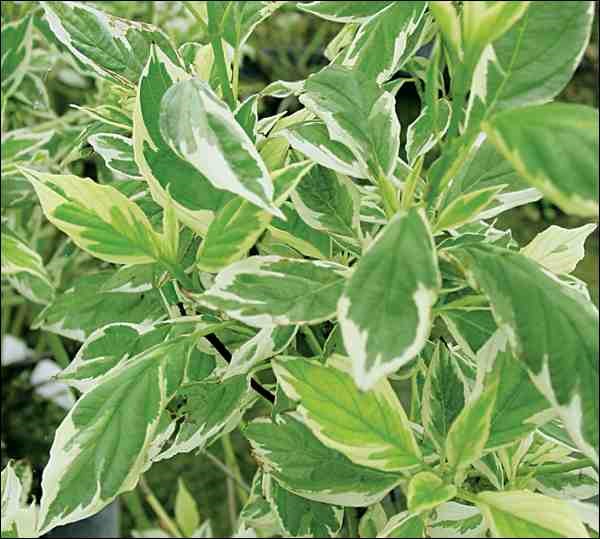Gardeners have an enormous appreciation for variegated foliage - leaves that contain white, cream, pink, yellow or purple in addition to the "normal" green. Like shrubs with golden and silver foliage, variegated shrubs can be used to show off shrubs with purplish foliage. Plant them adjacent to and slightly behind the shrubs with the purple foliage for the best effect.
Although many shrubs have variegated foliage (varying from pinkish through gold and white-silver), the hardiest, the most striking and the most readily available are found among the dogwoods (Cornus). Several species have prominent variegation.
Red-osier dogwood (Cornus sericea, syn. C. stolonifera) is native to the Canadian prairies, often found growing wild on the edge of sloughs or bush in moist situations. But red-osier dogwood is surprisingly adaptable and moderately drought tolerant once established.
It has an irregular but somewhat mound-like form, with a height and width of 1.8 to 2.7 metres. The green leaves, opposite and simple, are prominently veined, oval and with pointed tips, turning red purple in fall. The small, white, flat-topped clusters of flowers in May and June give rise to bluish-white berries. The stems are dull red, becoming greyish with age and increased diameter (not unlike people). Red-osier dogwoods grow well in full sun to partial shade (up to 70% shade), with the best fall foliage colour in full sun. They tolerate a range of soils. Although they do better with even moisture, they are moderately drought tolerant once established. The oldest stems can be removed at ground level to promote new growth with a bright red stem colour to enhance your winter landscape. They are well placed in shrub borders, as foundation plantings or used in naturalization.
Silver and Gold is large (1.8 metres in height and spread) and better used in larger landscapes. It has variegated green foliage with a white margin and yellow stems and good winter value.
White Gold, with a height and spread of 2.5 metres, has green and creamy white variegated foliage and bright gold winter stems.
There are many variegated selections of Tartarian dogwood (Cornus alba). 'Argenteo-marginata', the silver-leafed dogwood, has a height and spread of 1.5 to 2 metres, variegated grey-green and creamy white foliage and red winter stems. It does best in partial shade.
Ivory Halo is an upright, compact selection. The green leaves have white margins, and the stems are red in winter. It has a rounded form and is 1.5 metres in height and spread.
'Gouchaltii' (aka Gold and Rose) is more rounded than most, with a height and spread of 2 metres. It has variegated green leaves with yellow margins, often with a pink tinge, and red winter stems. Unfortunately, it appears susceptible to aphids.
Silver Charm is a dense, slow-growing, dwarf dogwood, approximately 1 metres in height and spread with silver and green variegation. It's well suited to a smaller landscape.
Willaims is the author of the new and revised 'Creating the Prairie Xeriscape.' In her latest book, 'Saskatoon Forestry Farm Park & Zoo: A Photographic History,' she tells of the history of an institution and the personal stories of the people who made an important impact on Prairie agriculture.
- This column is provided courtesy of the Saskatchewan Perennial Society (www.saskperennial.ca; [email protected]). Check out our Bulletin Board or Calendar for upcoming garden information sessions: Oct. 22, A History of the Forestry Farm Park and Zoo, 7:30 p.m. at Emmanuel Anglican Church on Dufferin St.




